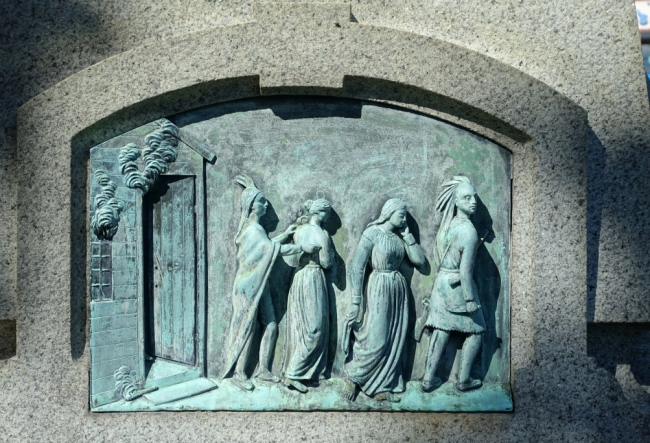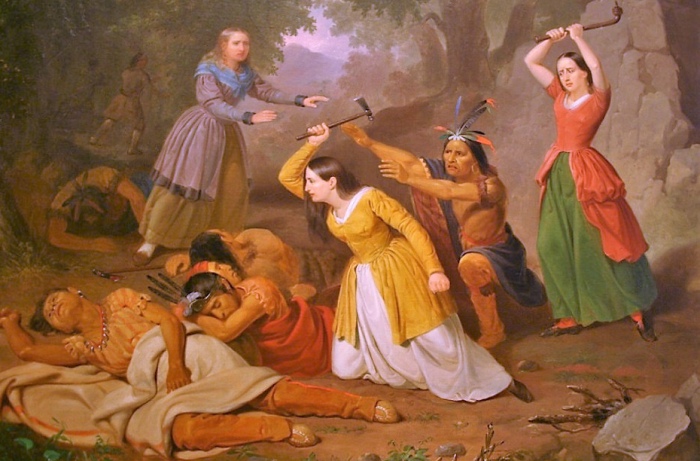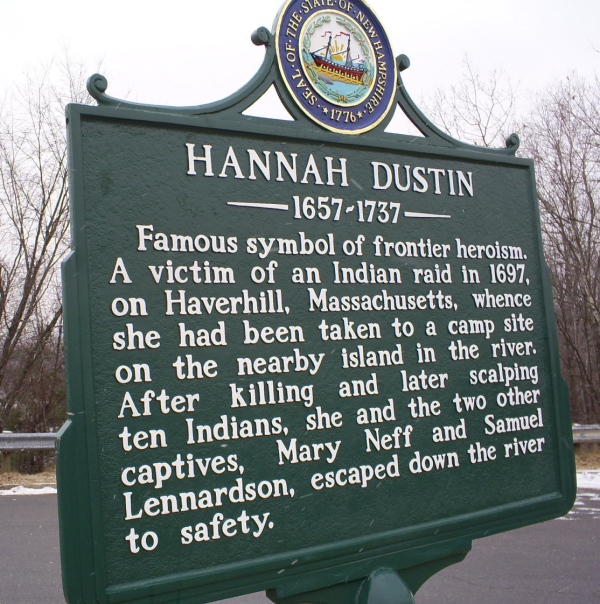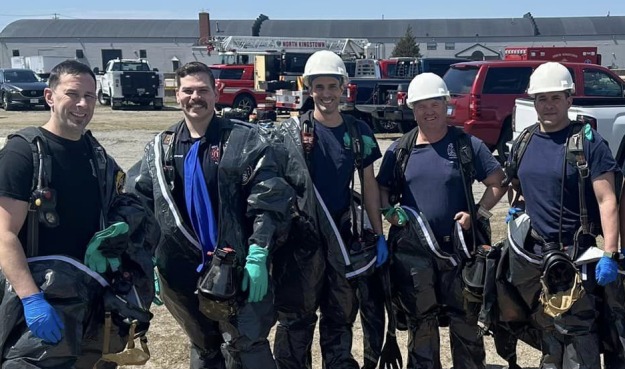In Haverhill stands a monument erected in 1879 that is in honor of colonist Hannah Duston. As the legend goes in 1697, during the King William’s War, the settlement was raided by 30 members of the Abenaki tribe from Quebec as the settlers slept. The Abenakis burned the village down and killed 27 people, many of who were children, as they went through the settlement. In addition, they took 13 people captive.
Duston’s husband was with 8 of their children building their home at the outskirts of the village and he managed to take them to safety, however, Hannah was captured along with 13 others which included her 6-day old baby, Martha, and her nurse Mary Neff.

Hannah Duston Monument, by Calvin H. Weeks, 1879
All the remaining captives were then brought to a small island in Boscawen, N.H., and on the long trek, according to Puritan minister Cotton Mather, the captors fed up with the baby’s crying, smashed the baby against a tree, killing it. Along the way, any settler who complained, were too tired to continue, or were injured were also dispatched.
When the trekkers reached their destination they – men, women, and children – were stripped, flogged, then forced to “run the gauntlet,” which is to say that they were all forced to run between two rows of Abenaki, who would then strike them with punches, kicks, sticks or other weapons.
One evening while everyone slept, an infuriated Hannah, her nurse, and a man by the name of Samuel Lennardson sought revenge. Grabbing their captor’s hatchets, they hacked to death the Abenaki who were watching over them: 2 men, 2 women, and 6 children. When finished the settlers scalped those who didn’t run away as there was a reward giving for all Indian scalps.
Commandeering a canoe, they then escaped and returned back to Haverhill to tell their tale.
However, historians are unsure about which elements of the story are true and which are legend or propaganda. Were the captors actually Native American or French? Did they actually kill her baby or did it die of natural causes later? Did colonists steal the land from the natives? Did the settlers harm or even kill a member of the tribe increasing tension among the two groups? Was something left out? If so, how much?
 Raid on Haverhill by Brutus.
Raid on Haverhill by Brutus.The statue in Massachusetts has her holding the hatchet she supposedly used, the one in New Hampshire has her clutching a handful of scalps – both considered somewhat gruesome, but the inscription on the monument in Massachusetts refers to her Indian captors as ‘savages’ which is a term that has offended some groups. City Council voted and decided to keep the statue but remove the hatchet and update the inscription removing the offensive term.
Haverhill’s Mayor Fiorentini had no qualms with the city council’s decision and even went further and suggested the erecting of a new memorial alongside the Duston statue in honor of Native Americans as a sort of historical balance. He has even gone so far as to form a commission comprised of local Amerindians to do so.
Members of the Cowasuck Band of the Pennacook Abenaki People who are indigenous to the area want that sense of historic balance, an imbalance that they say has been taught to all Americans in schools – a false narrative that portrayed Amerindians as the “bad guys.”
According to Indian legend and some historians, Mather embellished, sensationalized, even fabricated most of the story and point out that Mather played a prominent role in one of Massachusetts’ worst moments: the Salem witch trials, and not to be trusted.

Photo by Craig Michaud. This Historical sign in in Boscawen, New Hampshire.
Furthermore, historians doubt the veracity of the story and point to the fact that when Native Americans took women captive it wasn’t customary to restrain or lock up women as they were not seen as combatants, or a threat. With many holes in the story, perhaps a victim of Chinese whispers, and the lack of integrity connected to its storytellers, there’s no way to know the full story with any accuracy.
Echoing today’s political and social climate, there are many who say that even if the story is true, it is “racist” and “glorifies violence.” The truth is that settlers and Native Americans alike both committed savage, inhumane acts, slaughtered men, women, children, and babies alike. Like any conflict between peoples through history, it is a story of perspectives – one person’s freedom fighter is another person’s terrorist, one person’s insurgence is another person’s resistance against tyranny.
All this demonstrates is that through mankind’s history we have treated each other with abhorrent inhumanity, that the victors dictated the accounts since the vanquished no longer had a voice, and that it is both sides who were violent, immoral, and cruel. It doesn’t have to be one side or the other – we don’t have to choose, for choosing usually is a matter of subjective bias – it can be that both sides are in the wrong. In this case, we don’t need to condemn either group, the settler or the Native American, but we can condemn the violent actions, the murdering, the kidnapping, the pillaging.
To do otherwise is to continue the cycle of ignorance and perpetuate and breed more division which – the very thing that led to incidents like that which happened in Haverhill in 1697. The way to break this cycle, is to put aside differences, focus on our commonalities, extend an olive branch in the form of compassion, charity, and understanding of the other side’s point of view.

Something that is highly relevant and pertinent in today’s political turmoil, Republican vs Democrat, Liberal vs Conservative. Both sides being nasty, cruel, insulting, even physically attacking the other side in a “he said, she said.” Plenty can be said about each side when it comes to being “toxic,” intolerant, and hateful, but if you stand outside of those two groups you can see that they are both groups are just shades of the same color. Hating someone because you think they said or did something bad, is nonetheless, still hate.
“You think that good means hating what is bad. What’s bad is the hating mind itself.”-Bankei.
 New Bedford Guide Your Guide to New Bedford and South Coast, MA
New Bedford Guide Your Guide to New Bedford and South Coast, MA









Chinese whispers?
https://en.wikipedia.org/wiki/Chinese_whispers